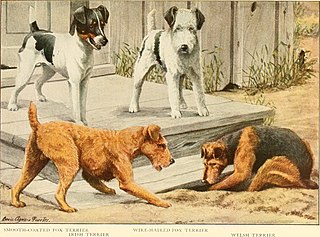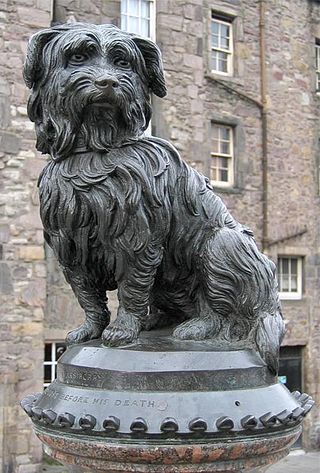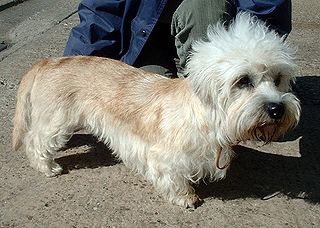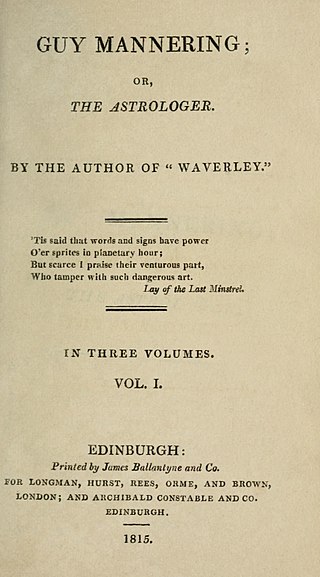
Terrier is a type of dog originally bred to hunt vermin. A terrier is a dog of any one of many breeds or landraces of the terrier type, which are typically small, wiry, game, and fearless. Terrier breeds vary greatly in size from just 1 kg (2 lb) to over 60 kg and are usually categorized by size or function. There are five different groups of terrier, with each group having different shapes and sizes.

The Scottish Terrier, popularly called the Scottie, is a breed of dog. Initially one of the highland breeds of terrier that were grouped under the name of Skye Terrier, it is one of five breeds of terrier that originated in Scotland, the other four being the modern Skye, Cairn, Dandie Dinmont, and West Highland White terriers. They are an independent and rugged breed with a wiry outer coat and a soft dense undercoat. The First Earl of Dumbarton nicknamed the breed "the diehard". According to legend, the Earl of Dumbarton gave this nickname because of the Scottish Terriers' bravery, and Scotties were also the inspiration for the name of his regiment, The Royal Scots, Dumbarton’s Diehard. Scottish Terriers, were originally bred to hunt vermin on farms.

Selkirk is a town and historic royal burgh in the Scottish Borders council district of southeastern Scotland. It lies on the Ettrick Water, a tributary of the River Tweed.

Selkirkshire or the County of Selkirk is a historic county and registration county of Scotland. It borders Peeblesshire to the west, Midlothian to the north, Roxburghshire to the east, and Dumfriesshire to the south. It derives its name from its county town, the royal burgh of Selkirk. The county was historically also known as Ettrick Forest.

Greyfriars Bobby was a Skye Terrier or Dandie Dinmont Terrier who became known in 19th-century Edinburgh for spending 14 years guarding the grave of his owner until he died on 14 January 1872. The story continues to be well known in Scotland, through several books and films. A prominent commemorative statue and nearby graves are a tourist attraction.

The Australian Terrier is a small breed of dog of the terrier dog type. The breed was developed in Australia, although the ancestral types of dogs from which the breed descends were from Great Britain.

The Bedlington Terrier is a breed of small dog named after the mining town of Bedlington, Northumberland in North East England. Originally bred to hunt, the Bedlington Terrier has since been used in dog racing, numerous dog sports, as well as in conformation shows and as a companion dog. It is closely related to the Dandie Dinmont Terrier, Whippet and Otterhound.

A Dandie Dinmont Terrier is a small Scottish dog breed in the terrier family. The breed has a very long body, short legs, and a distinctive topknot of hair on the head. They are friendly but tough, and are suitable for interaction with older children. There are breed-specific health concerns: they can be affected by spinal problems due to their elongated body, and the breed is affected by canine cancer at a higher than average rate.
Pringle is a Scottish surname.

Guy Mannering; or, The Astrologer is the second of the Waverley novels by Walter Scott, published anonymously in 1815. According to an introduction that Scott wrote in 1829, he had originally intended to write a story of the supernatural, but changed his mind soon after starting. The book was a huge success, the first edition selling out on the first day of publication.

An earthdog test or earthdog trial tests the working ability and instinct of the small, often short-legged terriers or Dachshunds. These dogs were bred to hunt vermin and other quarry which lived in underground dens. Earthdog den tests involve man-made tunnels that the dogs must navigate, while scenting a rat, "the quarry". The dog must follow the scent to the quarry and then "work" the quarry. Depending on the sanctioning organization, "working" means barking, scratching, staring, pawing, digging; any active behavior. The quarry is protected at all times by wooden bars across the end of the tunnel. The hunting encounter is controlled, and neither the dog nor the quarry are endangered by the activity.

Yair, also known as The Yair, is an estate in the Scottish Borders. It stands by the River Tweed in the former county of Selkirkshire, 2.5 miles (4.0 km) north-west of Selkirk, and 28 miles (45 km) south of Edinburgh. The name comes from the old Scots word for a fish trap. The estate is centred on Yair House, which is protected as a category A listed building. The nearby Yair Bridge is also category A listed.

The Paisley Terrier was a breed of terrier-type dog that is now extinct. Originating in Scotland, the Paisley Terrier was bred primarily as a pet and showdog version of the Skye Terrier, and was the progenitor of today's Yorkshire Terrier. The breed was called the Paisley Terrier since most of the dogs came from that location, but it was also called the Clydesdale Terrier, for another location in the Clyde Valley where the dogs were bred.

Old Jock (1859–1871), was a Fox Terrier famous during the late 19th and early 20th centuries. A mostly white dog, he ran briefly with a hunting kennel before becoming a show dog, most notably with a victory at the show which popularised the Fox Terrier. His main show rivalry was with a dog named Tartar, and along with a dog named Trap, the three were popular sires of the Fox Terrier breed. He was also involved in the early formation of the Jack Russell Terrier and the Dandie Dinmont Terrier breeds.
Events from the year 1875 in Scotland.
Before the Acts of Union 1707, the barons of the shire of Selkirk elected commissioners to represent them in the unicameral Parliament of Scotland and in the Convention of the Estates.
John Pringle, Lord Haining was a Scottish lawyer, politician, and judge. His ownership of a large estate near Selkirk secured him a seat in the Parliament of Scotland from 1702 until the Act of Union in 1707, and then in the House of Commons of Great Britain from 1707 until he became a Lord of Session in 1729.

John Pringle (c.1716-1792), was a Scottish merchant and politician who sat in the House of Commons between 1765 and 1786.
James Cowan Smith was a British civil engineer and philanthropist. He lived in Yorkshire and Nottinghamshire and was director of a railway company. In his last will and testament he left a bequest of more than £55,000 to the National Gallery of Scotland to be used to expand its collections. The fund has since purchased more than 40 works of art, produced by some of the world's most famous artists. An unusual condition of the bequest was that a portrait of his dog, a Dandie Dinmont terrier named Callum, was to be on permanent display at the gallery. The gallery has honoured this request ever since.















